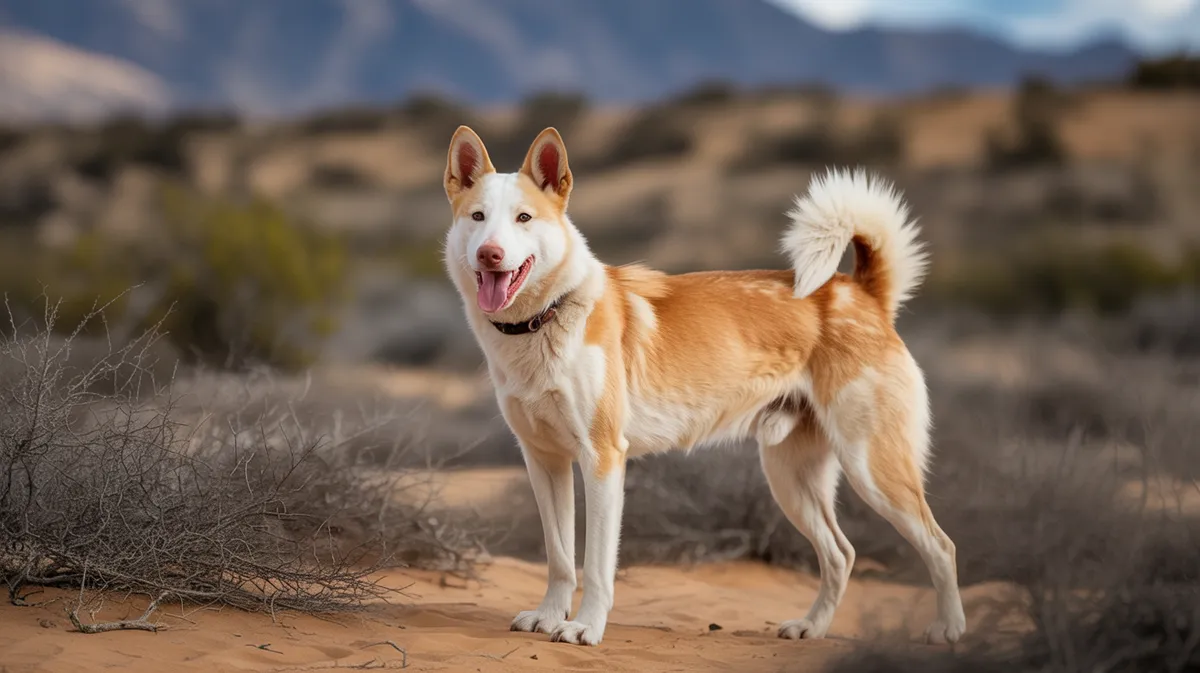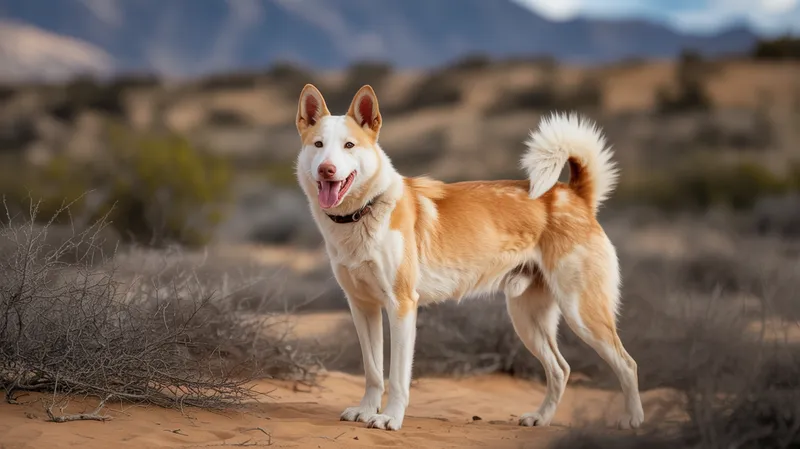
Canaan Dog
Canis lupus familiaris

Meet the Canaan Dog
The Canaan Dog is an ancient breed indigenous to the Middle East, particularly Israel, where it has survived for thousands of years as a pariah or wild dog. Known for its intelligence, agility, and adaptability, the breed was traditionally used for herding and guarding livestock by Bedouins and later served as a messenger and search-and-rescue dog. Canaan Dogs have a medium build, erect ears, bushy tails, and a dense double coat that comes in various colors, most commonly cream, sand, or black. Loyal and alert, they are highly trainable, making them excellent companions and working dogs.
Classification
Mammal
Habitat
Desert and semi-desert regions, scrublands, and open country
Diet
Omnivore
Lifespan
12-15 years
Conservation
Least Concern
Weight
18-25 kg
📖Fascinating Facts
Desert Survivor
The Canaan Dog is uniquely adapted to arid desert conditions, with a hardy constitution and strong survival instincts.
Ancient Breed
Archaeological evidence suggests that Canaan Dogs have existed in the Middle East for thousands of years, possibly as early as 9,000 years ago.
Keen Senses
Their exceptional hearing and sense of smell made them valuable as search-and-rescue dogs and landmine detectors.
📋Detailed Description
The Canaan Dog is a medium-sized, well-balanced breed, typically standing 50–60 cm (20–24 in) at the shoulder for males and 45–50 cm (18–20 in) for females, with males weighing 18–25 kg (40–55 lbs). Its body is slightly longer than tall, with a deep chest and a level topline. The head is wedge-shaped with a moderate stop, erect, low-set ears, and almond-shaped, dark brown eyes that convey alertness. The tail is bushy and carried curled over the back when excited. The dense double coat consists of a harsh, straight outer layer and a soft undercoat, providing insulation against both heat and cold. Coat colors are highly variable, with desert shades such as sand, gold, and cream being most common, but red, black, white, and spotted patterns also occur. Canaan Dogs are highly agile and possess remarkable endurance, traits that reflect their origins as free-ranging desert dogs. Their senses, particularly hearing and smell, are exceptionally acute, aiding in both predator detection and foraging. Socially, they display a strong territorial instinct and are naturally wary of strangers, yet form deep bonds with their families. Their intelligence and problem-solving abilities are notable, making them adept at tasks ranging from herding to search-and-rescue.
💡 Did you know?
The Canaan Dog was used by the Israeli military during World War II for mine detection, message delivery, and guard duties.
🔬Research & Sources
Wikipedia Summary
The Canaan Dog is a dog breed developed in the early 20th century from semiwild pariah dogs that were the descendants of animals present in the region since biblical times. It is the national dog of Israel and can be found in Israel, Jordan, Lebanon, Palestine, and the Sinai Peninsula. As of 2012, there were 2,000 to 3,000 Canaan Dogs across the world.
Last Modified: 5/23/2025
🎭Behavior & Social Structure
Canaan Dogs are vigilant and highly responsive to environmental stimuli, exhibiting a strong startle reflex and a natural suspicion of unfamiliar people or animals. In the wild and semi-wild populations, they are primarily crepuscular, being most active at dawn and dusk to avoid the heat of the day. Their diet is opportunistic and omnivorous, including small mammals, insects, carrion, fruits, and human refuse. They are skilled hunters, employing stealth and patience to stalk prey, but will also scavenge when necessary. Social structure in feral populations is flexible, with loose packs often forming around food sources or breeding females, though solitary individuals are common. Canaan Dogs communicate through a range of vocalizations, body postures, and scent marking. In domestic settings, they are highly trainable but require consistent, positive reinforcement due to their independent nature. They excel in activities that challenge their intelligence and agility, such as obedience, tracking, and agility sports.
👶Reproduction & Life Cycle
The Canaan Dog is a seasonal breeder, with females typically coming into estrus once a year, usually in late winter to early spring. Courtship involves ritualized behaviors such as circling, sniffing, and play-bowing. After successful mating, the gestation period lasts approximately 60–63 days. Litters usually consist of 4–6 puppies, though larger litters are not uncommon. In both wild and domestic settings, the mother provides the majority of parental care, nursing and protecting the pups in a secluded den for the first few weeks. Paternal involvement is variable but can include guarding the den and bringing food. Puppies are weaned at around 6–8 weeks and begin to explore their environment under the watchful eye of the mother. Sexual maturity is reached at about 10–12 months, though full social maturity may take up to two years.
🛡️Adaptations & Survival
The Canaan Dog exhibits several adaptations for survival in arid and semi-arid environments. Its dense double coat insulates against temperature extremes and provides protection from thorny vegetation. The breed’s lean, muscular build and efficient gait enable it to cover long distances in search of food and water. Acute senses of hearing and smell aid in detecting prey and predators. Behavioral adaptations include a high degree of wariness and the ability to quickly assess threats, as well as a flexible social structure that allows for both solitary and group living depending on resource availability. Their omnivorous diet and opportunistic feeding strategies are key to surviving in harsh, resource-scarce habitats. The breed’s intelligence and problem-solving skills are evolutionary responses to the challenges of a variable environment.
📚Research Sources
🎨Cultural Significance
The Canaan Dog holds a unique place in Middle Eastern history and culture, regarded as the national dog of Israel. Archaeological evidence and ancient texts suggest that dogs resembling the modern Canaan Dog have existed in the region since biblical times, serving as herders, guards, and companions to nomadic Bedouins. The breed was formally recognized and standardized in the 20th century by Dr. Rudolphina Menzel, who saw their potential as working dogs for the Haganah and later the Israeli military. Today, the Canaan Dog symbolizes resilience and adaptation, featuring in Israeli folklore and national iconography. It is also celebrated in regional art and literature as a living link to the ancient past.
🔬Recent Research & Discoveries
Recent genetic studies have confirmed the Canaan Dog’s close relationship to indigenous Middle Eastern pariah dogs, supporting its status as one of the few modern breeds with ancient origins. Ongoing research focuses on the breed’s genetic diversity, behavioral ecology, and resistance to certain diseases, which may offer insights into canine domestication and adaptation. Field studies in Israel and the Sinai Peninsula are monitoring wild populations to assess the impact of urbanization and hybridization. Notably, the breed’s exceptional olfactory abilities have been investigated for applications in search-and-rescue and medical detection work. Conservation genetics projects are underway to maintain the breed’s unique characteristics and prevent loss of genetic diversity.
🎥Wildlife Videos

Wildlife - Just Wild Dogs | Free Documentary Nature
Wildlife - Episode 7: Just Wild Dogs | Wildlife Documentary Watch 'Wildlife - Episode 8' here: https://youtu.be/kglJpB4ei8o Run ...
Free Documentary - Nature

CANAAN DOGS: THE ULTIMATE DESERT DOG
The Canaan Dog was developed from redomesticated Pariah Dog stock captured in the Palestine, where they were first used for ...
Dogumentary TV

Man's First Friend - The Epic Story of Dogs & Humans | Free Documentary Nature
Man's First Friend - Ths History of Dogs & Humans | Nature Documentary Watch 'Wildlife - Just Wild Dogs' here: ...
Free Documentary - Nature

Canaan Dogs have a strong survival instinct. They are quick to react and wary of strangers
pet #animal Are Canaan dogs good family pets? Canaan Dogs can make wonderful family companion dogs - but not for every ...
Animal Square
![Wild Dogs | National Geographic Wild Documentary [Full HD 1080p]](https://i.ytimg.com/vi/hLzJQMSZsBc/maxresdefault.jpg?sqp=-oaymwEcCOADEI4CSFXyq4qpAw4IARUAAIhCGAFwAcABBg==&rs=AOn4CLABKfWTL-ZIYEVrePsxEbJTAP4Hag)
Wild Dogs | National Geographic Wild Documentary [Full HD 1080p]
Wild Dogs | National Geographic Wild Documentary [Full HD 1080p] #wildplanet #wilddogs #documentary ----------------------- The ...
Wild Planet

Wild Canada - Nature's Untamed Beauty | Full Series | Free Documentary Nature
Wild Canada - Nature's Untamed Beauty | Wildlife Documentary Watch 'Darkwoods - Canada's Hidden Nature Reserve' here: ...
Free Documentary - Nature
🌍Habitat Information
The Canaan Dog typically inhabits Desert and semi-desert regions, scrublands, and open country environments. Canaan Dogs have adapted to their environments with specialized features and behaviors.
Primary Habitat:
Desert and semi-desert regions, scrublands, and open country
More detailed habitat information will be available soon.
🛡️Conservation Status
The Canaan Dog is currently classified as Least Concern. Conservation efforts are crucial for preserving this species for future generations.
Common Threats:
- 🏠Habitat loss and fragmentation
- 🌡️Climate change impacts
- 🎯Hunting and poaching
- 🏭Human-wildlife conflict
⚠️Threats & Conservation Challenges
While the Canaan Dog is not currently considered at risk globally, its wild and semi-wild populations face significant challenges. Habitat loss due to urban expansion, agricultural development, and infrastructure projects in the Middle East has reduced available territory. Hybridization with domestic dogs threatens the genetic integrity of the breed, especially among free-ranging populations. Intentional culling and poisoning, often as part of stray dog control measures, have also impacted numbers. The global population remains small, with only 2,000–3,000 individuals reported worldwide as of 2012, and the breed is considered rare outside its native range. Conservation efforts focus on maintaining purebred lines and preserving the remaining wild populations in Israel and neighboring countries.
🔬Scientific Classification
Scientific Name
Canis lupus familiaris
Classification Hierarchy
🔍 About Taxonomic Classification
Taxonomic classification is a hierarchical system used by scientists to classify and organize living organisms based on shared characteristics and evolutionary relationships.
The system moves from broad categories (Kingdom) to increasingly specific ones, with each animal's scientific name typically consisting of its Genus and species.
📝Community Notes
Share your observations and insights about the Canaan Dog with our community of wildlife enthusiasts.
Join Our Community
Sign in to share your observations and connect with fellow wildlife enthusiasts.
Sign In to ContributeNo community notes yet
Be the first to share your observations about the Canaan Dog!
Explore Canaan Dog
Select a tab above to learn more about this amazing animal.
📸Photo Gallery
No photos available for this animal yet.
🌟Discover More Wildlife
Continue your journey of discovery with more fascinating animals from our database
